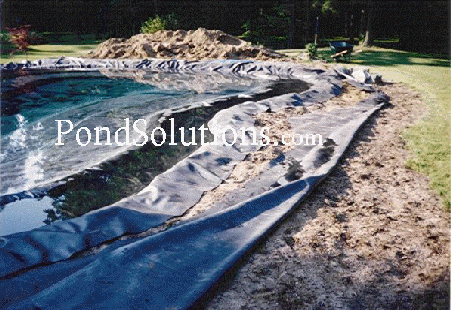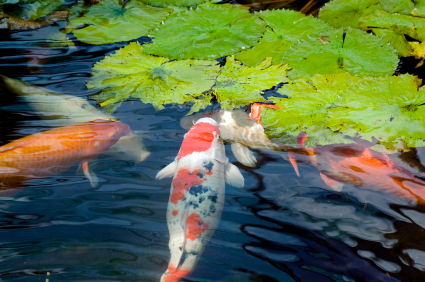How to Build a Koi Pond
Koi Pond Supplies and Information About Koi PondsA koi pond is one of the most popular types of water features all over the world. These colorful fish are enjoyable to watch with their bright colors and long, graceful fins. Once trained, they can become pets and may allow themselves to be touched or hand-fed. Although touching them isn't healthy for the fish as it removes part of their protective slime coat, hand-feeding can be enjoyable for all. |
|||
| A koi pond needs to have adequate filtration. There are a few things to consider as to what type of pond filter you choose. Typically, this filter should consist of a mechanical and biological filter. Both are very important.
A Pond filter will come with a chart from the manufacturer who made it. Within this chart, it will state what volume of pond water the filter is designed for and the quantity and size of fish. This is important and is the number one mistake pond owners make when creating their koi pond. They simply get a filter that is too small for their pond. |
|
||
| Since koi fish can get quite large - up to 2 or 3 feet long in the wild, they need adequate space to swim in the pond and definitely a large enough filtration system. When you create your koi pond know that this is a new hobby that will become addictive to you. When you buy 5 small' fish that are only 4 - 6 inches long, know that they will grow - and grow - and multiply - thereby outgrowing your pond filter. When in doubt, always go big - or even bigger - with your filtration system. | |||
|
|
So how do pond filters work at keeping your koi pond healthy? They work by providing mechanical and biological filtration. Mechanical filtration consists of some type of filter media such as filter pads, bio-balls™ or some type of filtering device that will filter large and fine particles within the water. The fish pond would be set up where the pump would be located at one end of the pond where it sucks in the water. The pump would then push the water to whatever water feature you have such as a pond waterfall, a fountain and/or a filter. The filter then filters the water and the water flows back into the koi pond via whatever water feature you've selected. The biological filter within koi ponds or any type of fish pond, is very important. The biological filter can consist of any surface area for good types of bacteria to grow on this can be within the filter or within the pond itself such as the surface area the rocks provide, pond plants, etc.. The more surface area within the pond or the filtration system, the larger your biological filter is. And, the larger your biological filter is, typically, the clearer your water will be which is something that everyone wants. |
||
|
Koi ponds have become the most popular water feature since the 1990s. Everyone enjoys the tranquil effect by watching the beautiful, graceful, japanese koi swim about in their fish pond. So, how do you keep the pond clean so you can enjoy it year-round? A koi pond can have a bit of debris build up if the pond isn't properly constructed. Although we have step-by-step instructions on how to build a pond, there are some other helpful tips to know on keeping it clean. |
|||
| It's ideal to have a drain installed in your koi pond. This would ideally be connected to your skimmer where your pump would be located. The pump then sucks in water from the pond, flows through the large filtering device and then flows to whatever water feature or pond filter you may have - or both. For other debris and fine silt that may collect in the pond, you can use a pond vacuum which works similar to a pool vacuum where you can easily vacuum out the debris.
Also, remove any dying pond plants or plant leaves within your koi pond. This will eliminate a lot of debris that typically cannot get sucked up through a drain or pond pump. It's important to remove as much debris as possible - or better yet, prevent as much debris as possible from getting in the koi pond to begin with, as this organic debris will simply add to nutrition for pond algae to grow. And, it's the number one thing that anyone with a water feature wants to achieve - is to eliminate the green algae from growing so they can see their prized fish! |
|
||
| Having an abundance of algae is common in most koi ponds. As stated above, most people don't have the right size of pond filter nor was their pond constructed the best way to remove any debris from building up which not only looks bad but adds to the nutrients that algae needs in order to grow.
There is something that's called string algae, too, which can grow prolifically in koi ponds and water gardens. String algae looks like long green hair and commonly grows on rocks, in shallow waters and in between water lilies and other aquatic plants. String algae grows by spores so be sure to remove or safely kill it with an aquatic algaecide (algae killer). A great product to use is Green Clean. You can help to prevent string algae from growing in your koi pond by placing small, organic, barley straw bales or bags in the filtration system of the pond. Barley straw has special enzymes to help prevent string algae from growing and is an all-natural way to prevent string algae from growing in the first place. A koi pond isn't much different than any other fish pond in regards to the type of filtration it needs nor how it should be constructed or maintained. All fish will need adequate filtration. If you ever owned an aquarium as a child, you probably remember this. The gravel served as a biological filter along with the plastic seaweed and other decorative pieces. You also would have had a type of filter to filter out the silt and fine debris within the aquarium and it would have had a pump to provide this water movement. You may have even had a small aerator or air stone. Having a koi pond or any fish pond is typically the same way only on a much bigger scale. And, thankfully we have real plants instead of plastic ones in our outdoor koi ponds. (Smile!) |
|||
 |
Another tip when designing your koi pond is to build the pond with either a raised edge or berm around it or construct it at a higher elevation of the nearby landscape. This is so lawn fertilizers and organic nutrients from your lawn doesn't flow into your pond when you water your lawn or when it rains. You would be surprised how much nutrients can get into your koi pond just from digging it in the wrong location or not having a berm around it. (See the slight elevation around the edge of the pond in the photo? A 10 - 20 percent grade is sufficient for this application.)
Koi will withstand cold water temperatures in your koi pond as they are cold water fish. They do need to be at least 6 inches long, though, to be large enough to keep outside during the cold, harsh winter. This fish pond should be at least 3 feet deep, if not around 5 feet deep. Because koi can get quite large, they need a lot of space to grow and swim around - both horizontally and vertically. |
||
|
Digging the pond around 5 feet deep will also allow extra space for the koi to be able to swim away from a predator such as a stalking blue heron or cat that would like to eat it for supper. So, do yourself and your koi fish a favor, dig the pond deeper to begin with. There are a variety of koi pond supplies available. Manufacturers are making more energy efficient pond pumps. There's more of a selection of pond filters and aerators as well. If you're considering building a koi pond for the first time, check out our pond kits. Many come complete with everything you need to build a pond including the pond liner, pump, underlayment, pump tubing, pond waterfall, skimmer and more. The best koi pond kit available on the market is our deluxe pond kit with a bottom drain. This will make the overall circulation of the pond great besides having the best effect of keeping it clean by sucking in silt and debris from the bottom drain.
|
|||



